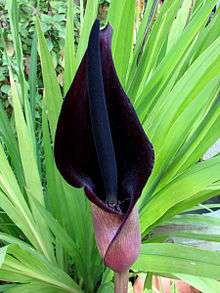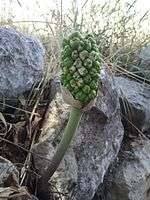Arum palaestinum
| Arum palaestinum | |
|---|---|
 | |
| Scientific classification | |
| Kingdom: | Plantae |
| (unranked): | Angiosperms |
| (unranked): | Monocots |
| Order: | Alismatales |
| Family: | Araceae |
| Subfamily: | Aroideae |
| Tribe: | Areae |
| Genus: | Arum |
| Species: | A. palaestinum |
| Binomial name | |
| Arum palaestinum Boiss. (1854) | |
| Synonyms[1] | |
| |
Arum palaestinum is a species of flowering herbaceous perennial plant in the family Araceae, also known as black calla, Solomon's lily, priest's hood, kardi and Palestine arum. This plant is native to Israel, Jordan, Lebanon, and Syria, and naturalized in northwestern California.[1][2][3]
It grows 10–25 cm (0.33–0.82 ft) high. It blooms from March to April. Each plant only blooms for a day, from morning to morning. The fruit contains seeds which are distributed by birds. The seeds are brown with a hard casing.

The plant gives off a strong scent of rotten fruit, with each species of Arum giving a different scent. The scent attracts flies, which distribute the pollen. The plant's flowering is special with the bottom part being feminine flowers and the top part being masculine flowers.[4]
In traditional medicine, the plant is used to deal with coughing with phlegm, hemorrhoids, parasitic worms in the stomach, constipation, and acne.
Israeli Jews use the leaves of the plant is their cuisine, it is especially popular in Jerusalem and the entire towns and villages region of around the city where it is called kardi, it is commonly eaten as part of a stews and soups with lentils, beans, meat, and kubba.
| Wikimedia Commons has media related to Arum palaestinum. |
See also
References
- 1 2 Kew World Checklist of Selected Plant Families
- ↑ Biota of North America Program, 2013 county distribution map
- ↑ Govaerts, R. & Frodin, D.G. (2002). World Checklist and Bibliography of Araceae (and Acoraceae): 1-560. The Board of Trustees of the Royal Botanic Gardens, Kew.
- ↑ Wild Flowers of Israel
- "Arum palaestinum". Integrated Taxonomic Information System. Retrieved April 19, 2013.